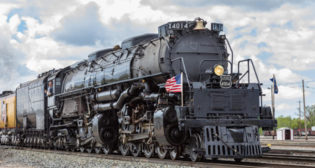
Foote: CSX 2Q “Most Disruptive Period I’ve Seen”
Written by Andrew Corselli
“CSX will emerge from this unprecedented period an even stronger company than before.”: President and CEO James Foote
CSX, the fourth Class I railroad to report second-quarter 2020 earnings, was hit hard by the freight traffic falloff and economy in recession created by the global COVID-19 pandemic, which appears to have entered a second wave in the U.S. CSX’s 2Q2020 net earnings of $499 million, or $0.65 per share, were a 57.4% free-fall compared to the 2019 period’s $870 million, or $1.08 per share.
Revenue for 2Q20 decreased 26% over the prior year to $2.26 billion, “primarily due to the lower economic activity driven by the COVID-19 pandemic,” CSX said. Expenses decreased 19% year-over-year to $1.43 billion, driven by “volume-related reductions and continued efficiency gains.” Operating income declined 37% for the quarter to $828 million compared to $1.31 billion in the same period last year. The operating ratio shot up by 600 basis points, to 63.3%.
“I want to extend my gratitude to all of the CSX employees who kept the railroad running well during the most disruptive operating period I have seen in my career,” said James M. Foote, President and CEO. “Their tireless efforts reflect our commitment to being the best-run railroad in North America and ensure CSX will emerge from this unprecedented period an even stronger company than before.”
THE COWEN INSIGHT

“CSX is a good company with solid fundamentals that is well positioned to benefit from long-term economic growth,” said Cowen and Company analysts Jason Seidl (Managing Director and Railway Age Wall Street Contributing Editor), Matt Elkott and Adam Kramer. “However, we would remain on the sidelines due to less-than-compelling valuation and transitory customer disruptions associated with the new leadership. The shares may be attractive to patient, long-term investors.”
CSX’s prospects are tied to factors that could affect the North American rail industry, near-term. On the upside, “Global demand for U.S. coal picks up, and truckload capacity tightens further thereby allowing the railroads to raise prices on their intermodal product. Service improves at a faster-than-expected rate,” the analysts noted. On the downside, “Economic growth proves unsustainable, and coal weakness lingers beyond expectations. The Presidential Administration provides more uncertainty.”
“CSX’s results were largely in line, with management calling it the most disruptive quarter they’ve ever seen. The pandemic, precipitous y/y declines in coal, and soft truckload prices took their toll, even with the company’s cost reduction efforts. We adjust our price target slightly higher to $74, but maintain our Market Perform rating.
“CSX’s reported EPS of $0.65 was slightly above our and the Street’s $0.61 and $0.64 estimates, respectively. Operating income of ~$828MM was above our $783MM estimate but below the Street’s $849MM expectation. Revenue of $2.26B was slightly below our and the Street’s $2.30B and $2.32B, respectively. The operating ratio (OR) of 63.3% was nearly 600 BPS worse y/y, ~270bps better than our estimate, and ~10 bps better than the Street’s. Relative to consensus, revenue in CSX’s Merchandise, Coal and Intermodal business units missed, while “Other Revenue”” beat
“In the quarter, management reduced train starts by 24%, saving more than $70MM in T&E (train and engine) expense. Similarly, overtime was reduced by 50%, saving $20MM. Finally, lower incentive compensation was a savings of $39MM. COVID-19 related costs were $10MM in the quarter, but should be only $1-2MM going forward, according to management. Though severance costs were a $10MM drag in the quarter, it should be a roughly $25MM annualized cost savings going forward. While CSX’s cost reduction initiatives in the quarter were impressive in our view, we continue to believe that the more recent PSR implementers are better positioned to keep a reduced cost profile as volumes return and identify more cost-cutting opportunities in the future.
“On the pricing front, average revenue per carload was negatively impacted by a significant decline in fuel [surcharges]. Excluding the revenue per carload figures for fuel [surcharges], they would have only been about 5-6% lower for Intermodal, and positive for the Merchandise business. This is a positive indication about the state of pricing for the Class I’s, as was foreshadowed in our pre-earnings 2Q20 Rail Shipper Survey. Given the upward momentum seen over the past two months in the trucking market, we believe intermodal pricing will recover going forward.
“We are adjusting our 2020 and 2021 EPS estimates to $3.65 and $4.20 from $3.60 and $4.05, respectively. Continuing to use a 17.5x multiple and our new 2021 EPS estimate, we arrive at our new price target of $74, up from $71.”



